All text contents ©1992, 1994, 1997, 1998, 1999 M.J. Farabee, all rights reserved. Use for educational purposed is heartily encouraged!
Epithelial Tissue | Connective Tissue | Muscle Tissue | Nervous Tissue | Links
Organs in animals are composed of a number of different tissue types. For example, the stomach:
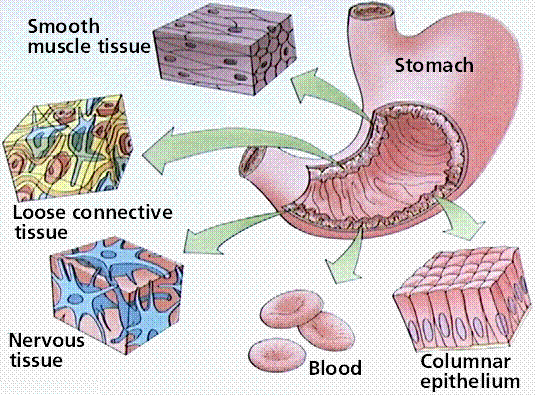
The above image is modified from http://www.whfreeman.com/life/update/.
Plants are simpler organisms than animals, having three organ systems and fewer organs than do vertebrate animals. Organs are composed of tissues, which are in turn composed of cells. Plants have three tissue types: ground, demal, and vascular. Animals have four: epithelial, connective, muscle, and bone.
Epithelial tissue covers body surfaces and lines body cavities. Functions include lining, protecting, and forming glands. Three types of epithelium occur:
Any epithelium can be simple or stratified. Simple epithelium has only a single cell layer. Stratified epithelium has more than one layer of cells. Pseudostratified epithelium is a single layer of cells so shaped that they appear at first glance to form two layers.

The above image is cropped from Loyola University's LUMEN site at http://www.meddean.luc.edu/lumen/MedEd/Histo/HistoImages/hl1-04.jpg. Note the single layer of simple cuboidal epithelium lining either side of a tubule.
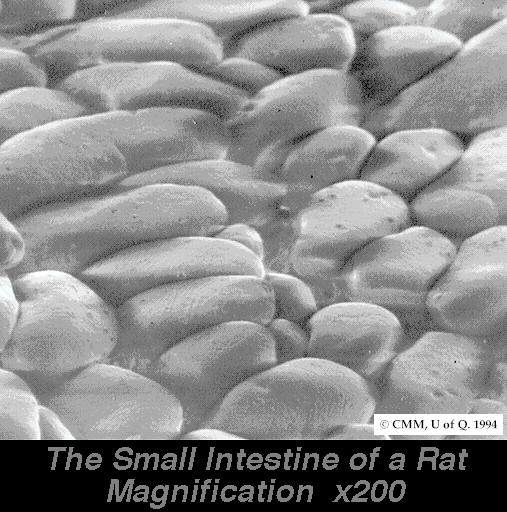
This image is from http://130.102.208.100/FMRes/FMPro?-db=images.fp3&key=32816&-img, used by permission of Nanoworld.
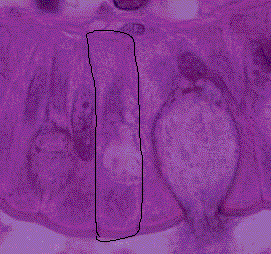
The above image is cropped and modified from Loyola University's LUMEN site at http://www.meddean.luc.edu/lumen/MedEd/Histo/HistoImages/hl1-12.jpg. Note: I have outlined one of the columnar epithelium cells.
Functions of epithelial cells include:
Glands can be single epithelial cells, such as the goblet cells that line the intestine. Multicellular glands include the endocrine glands. Many animals have their skin composed of epithelium. Vertebrates have keratin in their skin cells to reduce water loss. Many other animals secrete mucus or other materials from their skin, such as earthworms do.
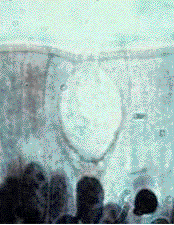
(The above image is from Loyola University's LUMEN site at http://www.meddean.luc.edu/lumen/MedEd/Histo/HistoImages/hl1-24.jpg).
Connective tissue serves many purposes in the body:
Connective cells are separated from one another by a non-cellular matrix. The matrix may be solid (as in bone), soft (as in loose connective tissue), or liquid (as in blood). Two types of connective tissue are Loose Connective Tissue (LCT) and Fibrous Connective Tissue (FCT). Fibroblasts (LCT) are separated by a collagen fiber-containing matrix. Collagen fibers provide elasticity and flexibility. LCT occurs beneath epithelium in skin and many internal organs, such as lungs, arteries and the urinary bladder. This tissue type also forms a protective layer over muscle, nerves, and blood vessels.
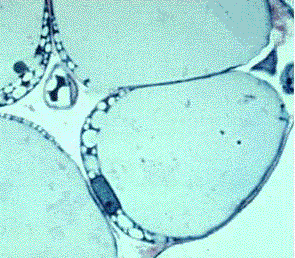
The above image of adipose tissue is cropped from Loyola University's LUMEN page at http://www.meddean.luc.edu/lumen/MedEd/Histo/HistoImages/hl2-11.jpg.
Adipose tissue has enlarged fibroblasts storing fats and reduced intracellular matrix. Adipose tissue facilitates energy storage and insulation.
Fibrous Connective Tissue has many fibers of collagen closely packed together. FCT occurs in tendons, which connect muscle to bone. Ligaments are also composed of FCT and connect bone to bone at a joint.
Cartilage and bone are "rigid" connective tissues. Cartilage has structural proteins deposited in the matrix between cells. Cartilage is the softer of the two. Cartilage forms the embryonic skeleton of vertebrates and the adult skeleton of sharks and rays. It also occurs in the human body in the ears, tip of the nose, and at joints.
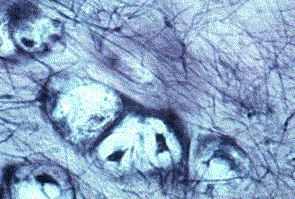
The above image of cartilage is cropped from Loyola University's LUMEN page at http://www.meddean.luc.edu/lumen/MedEd/Histo/HistoImages/hl4A-36.jpg.
Bone has calcium salts in the matrix, giving it greater strength. Bone also serves as a reservoir (or sink) for calcium. Protein fibers provide elasticity while minerals provide elasticity. Two types of bone occur. Dense bone has osteocytes (bone cells) located in lacunae connected by canaliculi. Lacunae are commonly referred to as Haversian canals. Spongy bone occurs at the ends of bones and has bony bars and plates separated by irregular spaces. The solid portions of spongy bone pick up stress.
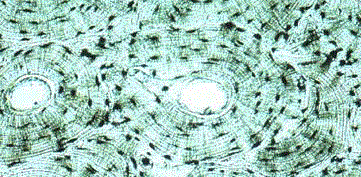
The above image of bone is cropped from Loyola University's LUMEN page at http://www.meddean.luc.edu/lumen/MedEd/Histo/HistoImages/hl4A-40.jpg. Note the haversian canal and surrounded by osteocytes and a mineralized matrix.
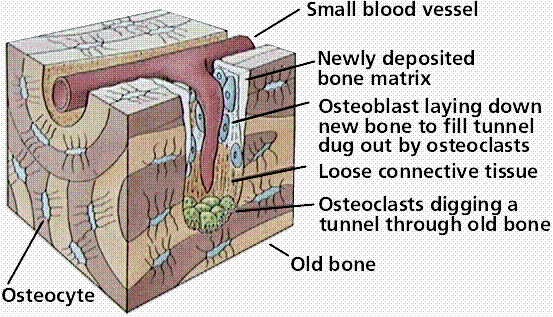
The above image is modified from http://www.whfreeman.com/life/update/.
Blood is a connective tissue of cells separated by a liquid (plasma) matrix. Two types of cells occur. Red blood cells (erythrocytes) carry oxygen. White blood cells (leukocytes) function in the immune system. Plasma transports dissolved glucose, wastes, carbon dioxide and hormones, as well as regulating the water balance for the blood cells. Platelets are cell fragments that function in blood clotting.
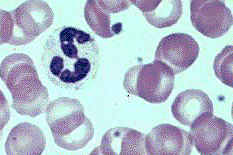
The above image is cropped from Loyola University's LUMEN site at http://www.meddean.luc.edu/lumen/MedEd/Histo/HistoImages/hl2B-51.jpg. Note the red blood cells and the single neutrophil.

The above image is cropped from Loyola University's LUMEN site at http://www.meddean.luc.edu/lumen/MedEd/Histo/HistoImages/hl2B-64.jpg. Erythrocytes as seem with the SEM.
Muscle tissue facilitates movement of the animal by contraction of individual muscle cells (referred to as muscle fibers). Three types of muscle fibers occur in animals (the only taxonomic kingdom to have muscle cells):
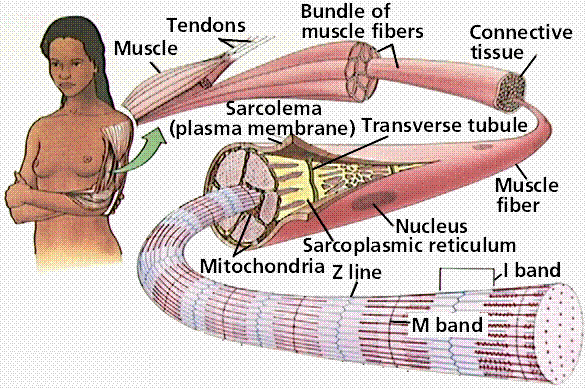
The above image is modified from http://www.whfreeman.com/life/update/.
Muscle fibers are multinucleated, with the nuclei located just under the plasma membrane. Most of the cell is occupied by striated, thread-like myofibrils. Within each myofibril there are dense Z lines. A sarcomere (or muscle functional unit) extends from Z line to Z line. Each sarcomere has thick and thin filaments. The thick filaments are made of myosin and occupy the center of each sarcomere. Thin filaments are made of actin and anchor to the Z line.
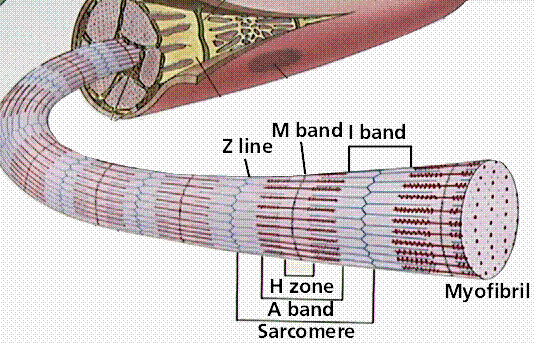
The above image is modified from http://www.whfreeman.com/life/update/.
Skeletal (striated) muscle fibers have alternating bands perpendicular to the long axis of the cell. These cells function in conjunction with the skeletal system for voluntary muscle movements. The bands are areas of actin and myosin deposition in the cells.
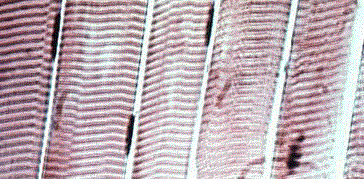
The above image of striated muscle fibers is cropped from Loyola University's LUMEN site at http://www.meddean.luc.edu/lumen/MedEd/Histo/HistoImages/hl3A-45.jpg.
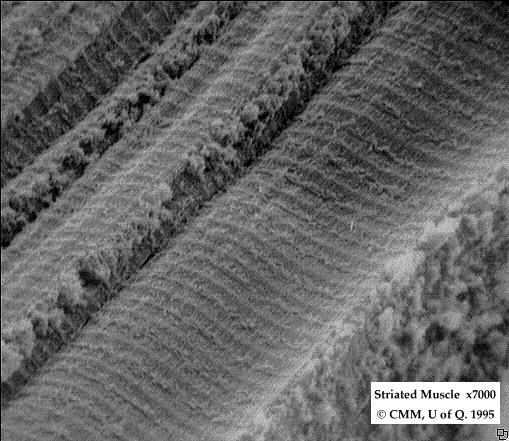
This image is from http://130.102.208.100/FMRes/FMPro?-db=images.fp3&key=32948&-img.
Smooth muscle fibers lack the banding, although actin and myosin still occur. These cells function in involuntary movements and/or autonomic responses (such as breathing, secretion, ejaculation, birth, and certain reflexes). Smooth muscle fibers are spindle shaped cells that form masses. These fibers are components of structures in the digestive system, reproductive tract, and blood vessels.
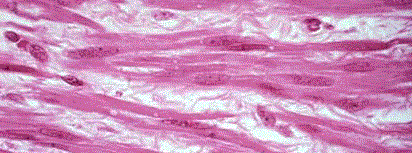
The above image of smooth muscle cells is cropped from Loyola University's LUMEN site at http://www.meddean.luc.edu/lumen/MedEd/Histo/HistoImages/hl3A-42.jpg.
Cardiac muscle fibers are a type of striated muscle found only in the heart. The cell has a bifurcated (or forked) shape, usually with the nucleus near the center of the cell. The cells are usually connected to each other by intercalated disks.
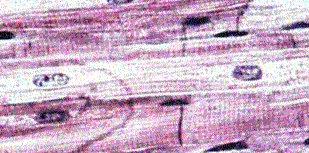
The above image of cardiac muscle cells is cropped from Loyola University's LUMEN site at http://www.meddean.luc.edu/lumen/MedEd/Histo/HistoImages/hl3A-48.jpg. Note the dark band of the intercalated disk that separates two muscle cells.
Nervous tissue functions in the integration of stimulus and control of response to that stimulus. Nerve cells are called neurons. Each neuron has a cell body, an axon, and many dendrites. Nervous tissue is composed of two main cell types: neurons and glial cells. Neurons transmit nerve messages. Glial cells are in direct contact with neurons and often surround them.
The neuron is the functional unit of the nervous system. Humans have about 100 billion neurons in their brain alone! While variable in size and shape, all neurons have three parts. Dendrites receive information from another cell and transmit the message to the cell body. The cell body contains the nucleus, mitochondria and other organelles typical of eukaryotic cells. The axon conducts messages away from the cell body.

The above image is modified from http://www.whfreeman.com/life/update/.
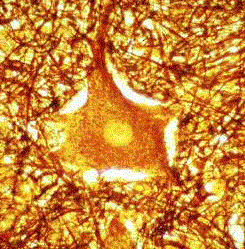
The above image of large multipolar neuron (center of image) is cropped from Loyola University's LUMEN site at http://www.meddean.luc.edu/lumen/MedEd/Histo/HistoImages/hl3-03.jpg.
Back to Table of Contents | ANIMAL ORGAN SYSTEMS AND HOMEOSTASIS
Email: farabee@emc.maricopa.edu![]()
Last modified: 1999/03/04:08:19:02
The URL of this page is: gened.emc.maricopa.edu/bio/BIO181/BIOBK/BioBookAnimalTS.html